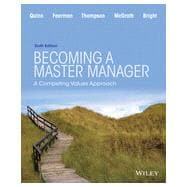Becoming a Master Manager is appropriate for management and organizational behavior courses that emphasize critical management skills that yield sound organizational results.
Developed from both theory and empirical evidence, the text provides a compelling case for why managerial and leadership competencies are essential for employee engagement, effective communication, and sustainable organizational success.
The competing values framework offers future managers a foundation for analyzing, understanding and executing the behavior that will achieve positive performance, productivity and profitability.








